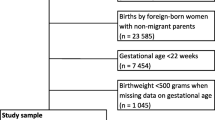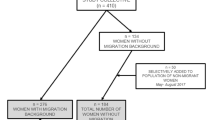Summary
Background
Immigration plays a major role in obstetrics in Austria, and about 18 % of the Austrian population are immigrants. Therefore, we aimed to (1) test the feasibility of a proposed questionnaire for assessment of migrant status in epidemiological research and (2) assess some important associations between procedures and outcomes in obstetrics and migration in selected departments in Austria.
Methods
We adapted a standardized questionnaire to the main immigration groups in Austria. Information on country of origin, length of residence in Austria and German-language ability was collected from eight selected obstetrics departments. Of the 1,971 questionnaires, 1,873 questionnaires of singleton births were selected and included in the analysis.
Results
We analyzed a total of 1,873 parturients with singleton births, of which 35 % had migrant status, 12 % were from ex-Yugoslavia, 12 % were from Turkey, and 12 % were from other countries. The proportion of parturients having their first care visit after the 12th week of pregnancy was higher in migrant groups (19 %). Smoking was highest in the migrants from ex-Yugoslavia (21 %). Vaginal delivery was more frequent in migrants from ex-Yugoslavia (78 %) and Turkey (83 %) than in nonmigrants (71 %) and episiotomy was more frequently performed in migrants from other countries. All differences are statistically significant.
Conclusions
Administration of a standardized questionnaire for assessment of migrant status in obstetric departments in Austria was shown to be feasible. We assessed differences in obstetric care and outcome and consequently recommend that action should be initiated in Austria toward harmonizing obstetric procedures among the migrant and the nonmigrant groups and toward minimizing risk factors.
Zusammenfassung
Grundlagen
Ungefähr 18 % der österreichischen Bevölkerung weisen einen Migrationshintergrund auf und Immigration nimmt auch in der Geburtshilfe einen immer größeren Stellenwert ein. Unsere Ziele waren es daher, 1) einen standardisierten Fragebogen für die Erfassung der Migrationshintergrundes in seiner Anwendbarkeit zu testen, und 2) Zusammenhänge zwischen Migrationshintergrund und der geburtshilflichen Versorgung und dem geburtshilflichem Outcome in ausgewählten Geburtenabteilungen in Österreich zu analysieren.
Methodik
Es wurde ein standardisierter Fragebogen eingesetzt, der neben Herkunftsland auch die Aufenthaltsdauer in Österreich sowie die Deutschkenntnisse abfragt. Der Fragebogen wurde auf alle Geburten im Zeitraum März bis Mai 2009 in acht ausgewählten Geburtenabteilungen in Österreich angewandt. In die Analyse wurden nur Einlingsgeburten aufgenommen.
Ergebnisse
Es konnten 1873 Fragebögen zu Einlingsgeburten analysiert werden, 35 % davon wiesen einen Migrationshintergrund auf (12 % aus Ex-Jugoslawien, 12 % aus der Türkei und 12 % aus anderen Ländern). Der Anteil der Frauen mit der ersten Schwangerschaftsuntersuchung nach der 12. Schwangerschaftswoche war bei Frauen mit Migrationshintergrund deutlich höher (19 vs. 9 %). Der Anteil der Frauen, die in der Schwangerschaft geraucht haben, war bei Migrationshintergrund Ex-Jugoslawien am höchsten mit 21 %. Bei Frauen mit Migrationshintergrund Ex-Jugoslawien und Türkei fanden mehr Vaginalgeburten statt (78 bzw. 83 %) verglichen mit Frauen ohne Migrationshintergrund (71 %). Alle Unterschiede waren statistisch signifikant.
Schlussfolgerungen
Der standardisierte Fragebogen für die Erhebung des Migrationshintergrundes war in der Geburtshilfe in Österreich gut anwendbar. Wir haben Unterschiede in der geburtshilflichen Versorgung und im geburtshilflichen Outcome bei Frauen mit Migrationshintergrund festgestellt und empfehlen daher Maßnahmen, diese Unterschiede auszugleichen, sowie Maßnahmen zur Reduzierung von Risikofaktoren, insbesondere Rauchen während der Schwangerschaft.


Similar content being viewed by others
Abbreviations
- APR:
-
Austrian Perinatal Registry
- BMI:
-
Body Mass Index
- PW:
-
Pregnancy Week
- CS:
-
Cesarean Section
- EDA:
-
Epidural Anesthesia
- SPA:
-
Spinal Anesthesia
- SGA:
-
Small for Gestational Age
References
Auger N, Giraud J, Daniel M. The joint influence of area income, income inequality, and immigrant density on adverse birth outcomes: a population-based study. BMC Public Health. 2009;9:237.
Gagnon AJ, Zimbeck M, Zeitlin J. Migration to western industrialised countries and perinatal health: a systematic review. Soc Sci Med. 2009 Sep;69(6):934–46.
Bollini P, Pampallona S, Wanner P, Kupelnick B. Pregnancy outcome of migrant women and integration policy: a systematic review of the international literature. Soc Sci Med. 2009 Feb;68(3):452–61.
Gissler M, Alexander S, Macfarlane A, Small R, Stray-Pedersen B, Zeitlin J, et al. Stillbirths and infant deaths among migrants in industrialized countries. Acta Obstet Gynecol Scand. 2009;88(2):134–48.
Norredam M. Migrants’ access to healthcare. Dan Med Bull. 2011 Oct;58(10):B4339.
Bischoff A, Denhaerynck K. What do language barriers cost? An exploratory study among asylum seekers in Switzerland. BMC Health Serv Res. 2010;10:248.
Auger N, Luo ZC, Platt RW, Daniel M. Do mother’s education and foreign born status interact to influence birth outcomes? Clarifying the epidemiological paradox and the healthy migrant effect. J Epidemiol Community Health. 2008 May;62(5):402–9.
Ekeus C, Cnattingius S, Hjern A. Epidural analgesia during labor among immigrant women in Sweden. Acta Obstet Gynecol Scand. 2010;89(2):243–9.
Romero AJ, Martinez D, Carvajal SC. Bicultural stress and adolescent risk behaviors in a community sample of Latinos and non-Latino European Americans. Ethn Health. 2007 Nov;12(5):443–63.
Aveyard P, Cheng KK, Manaseki S, Gardosi J. The risk of preterm delivery in women from different ethnic groups. BJOG. 2002;109(8):894–9.
Reime B, Lindwedel U, Ertl KM, Jacob C, Schucking B, Wenzlaff P. Does underutilization of prenatal care explain the excess risk for stillbirth among women with migration background in Germany? Acta Obstet Gynecol Scand. 2009;88(11):1276–83.
Puthussery S, Twamley K, Harding S, Mirsky J, Baron M, Macfarlane A. “They’re more like ordinary stroppy British women”: attitudes and expectations of maternity care professionals to UK-born ethnic minority women. J Health Serv Res Policy. 2008 Oct;13(4):195–201.
Lazdane G, Lazarus JV. Sexual and reproductive health in a multicultural Europe. Entres Nous. 2003:3–27.
Merten S, Wyss C, Ackermann-Liebrich U. Caesarean sections and breastfeeding initiation among migrants in Switzerland. Int J Public Health. 2007;52(4):210–22.
Wingate MS, Alexander GR. The healthy migrant theory: variations in pregnancy outcomes among US-born migrants. Soc Sci Med. 2006 Jan;62(2):491–8.
Baldaszti E, Kytir J, Marik-Lebeck S, Wisbauer A, Faßmann H. Migration & Integration. Zahlen Daten Indikatoren 2010. Wien: Statistik Austria; 2010.
AQUA: Datensatz Geburtshilfe 16/1 (Spezifikation 14.0 SR 1). Göttingen: AQUA-Institut für angewandte Qualitätsförderung und Forschung im Gesundheitswesen; 2010.
Schenk L, Bau AM, Borde T, Butler J, Lampert T, Neuhauser H, et al. A basic set of indicators for mapping migrant status. Recommendations for epidemiological practice. Bundesgesundheitsblatt Gesundheitsforschung Gesundheitsschutz. 2006;49(9):853–60.
Stata Statistical Software: Release 9.0. College Station, Texas, StataCorp LP.2005.
Koller D, Lack N, Mielck A. [Social differences in the utilisation of prenatal screening, smoking during pregnancy and birth weight—empirical analysis of data from the Perinatal Study in Bavaria (Germany)]. Gesundheitswesen. 2009;71(1):10–8.
Ergin I, Hassoy H, Tanik FA, Aslan G. Maternal age, education level and migration: socioeconomic determinants for smoking during pregnancy in a field study from Turkey. BMC Public Health. 2010 Jun 9;10(1):325.
Carrasco-Garrido P, De Miguel AG, Barrera VH, Jimenez-Garcia R. Health profiles, lifestyles and use of health resources by the immigrant population resident in Spain. Eur J Public Health. 2007 Oct;17(5):503–7.
Reeske A, Spallek J, Razum O. Changes in smoking prevalence among first- and second-generation Turkish migrants in Germany—an analysis of the 2005 microcensus. Int J Equity Health. 2009;8:26.
Borde T, David M, Kentenich H. [What Turkish-speaking women expect in a German hospital and how satisfied they are with health care during their stay in a gynaecological hospital in Berlin—a comparative approach]. Gesundheitswesen. 2002 Aug-Sep;64(8–9):476–85.
Borde T, Dudenhausen JW, David M. [Migrants in obstetrics–psychosomatic aspects in the context of acculturation]. Psychother Psychosom Med Psychol. 2008;58(3–4):183–8.
Heim K, Hofmann H, Lang U, Oberaigner W, Helmer H, Husslein P. Einheitliche Definition geburtshilflicher Begriffe für das Geburtenregister Österreich. Speculum. 2008;26(1):6–10.
El-Sayed AM, Galea S. Explaining the low risk of preterm birth among Arab-Americans in the United States: an analysis of 617451 births. Pediatrics. 2009 Mar;123(3):e438–45.
El Reda DK, Grigorescu V, Posner SF, Davis-Harrier A. Lower rates of preterm birth in women of Arab ancestry: an epidemiologic paradox—Michigan, 1993–2002. Matern Child Health J. 2007 Nov;11(6):622–7.
Urquia ML, Frank JW, Moineddin R, Glazier RH. Immigrants’ duration of residence and adverse birth outcomes: a population-based study. BJOG. 2010 Apr;117(5):591–601.
Maslovitz S, Kupferminc MJ, Lessing JB, Many A. Perinatal outcome among non-residents in Israel. Israel Med Assoc J. 2005 May;7(5):315–9.
Acknowledgments
We thank the midwives in the participating hospitals for their effort in filling in the standardized questionnaire, Patricia Gscheidlinger for the secretarial support and Mary Margreiter for native-speaker editing of the English.
Author information
Authors and Affiliations
Corresponding author
Rights and permissions
About this article
Cite this article
Oberaigner, W., Leitner, H., Oberaigner, K. et al. Migrants and obstetrics in Austria—applying a new questionnaire shows differences in obstetric care and outcome. Wien Klin Wochenschr 125, 34–40 (2013). https://doi.org/10.1007/s00508-012-0312-0
Received:
Accepted:
Published:
Issue Date:
DOI: https://doi.org/10.1007/s00508-012-0312-0




